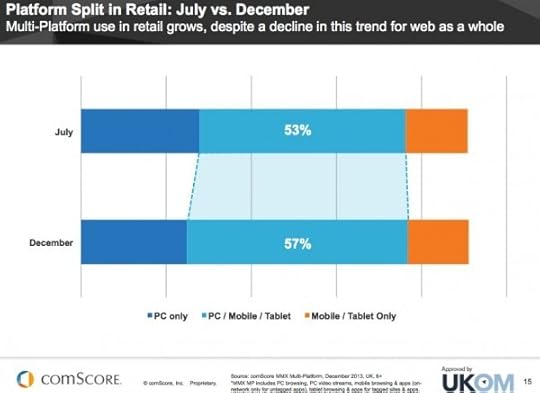Erik Qualman's Blog, page 604
April 19, 2014
What’s Using All the Bandwidth?
April 18, 2014
The Medium Is the Message: The Importance of Tracking Analytics across Devices

A recent report by comScore shows mobile devices accounted for 55 percent of online usage in the U.S. as of January, 2014, with apps making up 47 percent of traffic. With mobile users officially tipping the scales in search, marketers can’t afford to ignore the analytics and keep focusing on traffic and conversions from PC usage. Here’s a look at growing trends in search, consumer behavior and what’s driving content marketing.
Multi-platform tracking
In the early days of social media, experts would point to engagement numbers and reach as the most practical way to measure ROI. But it’s no longer enough to sit back and wait to see how your traffic shakes out and converts into paying customers and loyal fans. The digital landscape is rapidly changing from simply browsing from a PC, to mobile and beyond.
A 2014 market report by comScore shows the majority of consumers are multi-screening across mobile or desktop to shop online. Customers need a cohesive experience whether using their laptop, desktop, tablet, smartphone or otherwise. Optimizing a website for a smartphone requires a deep understanding of how users are browsing on their phones, how the layout of your site looks on a mobile device, if visitors can clearly read and click on information and what they’re searching for.
It’s not enough to simply give consumers a variety of ways to interact with your brand. Marketers need to look to multi-platform tracking to monitor traffic and conversions from our ever-changing digital climate. Google is already offering Universal Analytics for mobile app, gaming consoles and information kiosks tracking to figure out how users are actually interacting with information. KISSMetrics and moz Analytics are also good places to start with traffic monitoring.
Give consumers content where they want it
It’s tempting to think you can just continue on with the status quo since it’s been working this long. But not knowing where, how and why your users are interacting with your content means a missed opportunity to give them content where they use it most. If your customers are all looking for reviews on Yelp from their mobile devices, you can plot your next steps accordingly. Incorporate social media reviews into your marketing plan or buy Facebook ads to meet your audience where they look for you most.
Think bigger than traffic sources leading back to your site, and anticipate where consumers will go next. Research from the Google Shopper Marketing Agency Council shows 79 percent of smartphone owners are also avid smartphone shoppers. Ninety-percent of those use their phones for pre-shopping activities like finding promo codes, looking up store hours, and finding product information. Consider keeping your audience engaged by leaking promo codes and ensuring essential shopping information, like your return policy, are easily accessible via smartphone browsing.
And according to Google’s Mobile Path to Purchase report, 84 percent of smartphone shoppers use their devices to help them make purchases while still in the store, across everything from appliances down to pet care. They also found shoppers using mobile actually bought more than those without their phones. Tracking consumer behavior on mobile, and any device, is crucial to give your consumers what they want. Otherwise, they’ll simply find a search result to answer it for them and potentially take their business elsewhere.
How will customers find you?

How consumers end up on your website or other digital property is just as important to consider as what devices they’re using. According to Google’s mobile path to purchase report, 48 percent of those surveyed start their search on search engines, 33 percent start on a branded website, and 23 percent launch a search from a branded app. Neglecting any of the three could alienate a large percentage of potential customers.
While the report tells us search engines are still king, the rules have changed. Publishing a blog and writing consistent copy got companies ranked sooner than later. Today, brands need a carefully planned and executed content marketing strategy to rank for search. Ebooks, reports, podcasts, giveaways and the rapid rise of video all working together to raise brand awareness can improve your search results. But creating even the most valuable content can’t exist in a vacuum. Every piece of content you create also needs to be found online to work. This means using social media, building relationships with influencers and consistently promoting every piece of content is a necessary step towards getting found online.
Thumbnail: http://tinyurl.com/ljpordy
[image error]
April 17, 2014
The Best of WordPress in 2014: Hosting, Themes, & Plugins

WordPress powers approximately 19% of the web. It’s important for those who run WordPress sites to optimize with better hosting, themes, and plugins. However, with the wide range of options available, it can be difficult to make the right choices. Refer to this guide to learn what hosting providers, themes, and plugins stand out from the crowd and will allow you to make the most out of your WordPress site.
Top 5 Hosting Providers
1. Bluehost. Bluehost is a great choice for an inexpensive and reliable WordPress hosting provider. They are officially recommended by WordPress, and provide easy setup with an auto-installer and ensure that you have access to all WordPress updates within 24 hours for maximum security. They are currently in beta for their Managed WordPress Hosting platform.
2. HostGator. HostGator is another provider that offers inexpensive WordPress hosting with simplified installation. There is fast resolution for downtime and responsive customer service, which includes live chat. Other features include an easy-to-navigate admin panel and enhanced security with PHP running as suPHP.
3. WP Engine. While WP Engine hasn’t been around as long as some other providers, it offers the benefit of specializing exclusively in WordPress hosting. The managed service is both fast and secure. It also includes add-ons that are specific to the WordPress platform and provide the options and features your website needs.
4. iPage. iPage is a recently launched managed WordPress hosting solution. It offers 1-click installation and extremely responsive customer service. WP Essential offers faster site speeds in addition to dedicated WordPress experts, integrated themes and plugins, and automatic detection and removal of malware.
5. A Small Orange. A Small Orange provides inexpensive web hosting and reliable service, with a support team available 24/7. Features include 1-click installation and a range of hosting options, including shared, business, and cloud VPS.
Top 5 Themes
1. The X Theme. Many are referring to the X Theme as the theme of 2014. This multipurpose theme is useful for business websites, ecommerce, and portfolios. It combines functionality with premium design, and has received positive reviews from a range of top internet marketers. It also allows you to create an unlimited number of websites that all utilize the same theme.
2. Karma. Karma is a fully responsive WordPress theme that is parallax enabled. This is great for both business and creative websites. It offers features such as an Isotope Gallery with Fancybox, which enables easier sharing of video and images.
3. Natural. Natural is another multipurpose theme that can be used for portfolios, ecommerce, and business websites. While there are many different multipurpose themes on the WordPress circuit, Natural stands out with a wide range of features, including customizable templates and flexibility in terms of colors and other visuals.
4. vFlex. Designed with the needs of bloggers and designers in mind, vFlex is a responsive theme that is most popular for blogs and portfolios. It offers a FlexSlider for featuring certain images, as well as a VibeOptions panel that provides support for import and export settings, logo uploading – not to mention a range of other features.
5. Flozo. This free theme is fully responsive and perfect for business websites. It was specifically designed with the needs of startups and small businesses in mind, allowing them to easily launch professional websites on the WordPress platform.
Top 5 Plugins
1. All in One SEO Pack. The All in One SEO Pack, designed by Michael Torbet, is considered an essential plugin for WordPress sites. It can help optimize your website for search engines by identifying the best titles, homepage descriptions, and keywords for your topic.
2. Broken Link Checker. Broken Link Checker is an essential plugin for WordPress sites. It can monitor the website and notify you, either through email or the WordPress dashboard, if it discovers either broken links or missing images. It also allows for easy replacement of broken links.
3. W3 Total Cache. With W3 Total Cache, you can cover all caching bases. It not only allows for basic page caching, but also minifies your CSS, JavaScript, and HTML files. Furthermore, this plugin handles uploads to your CDN.
4. Disqus Commenting. To add enhanced commenting features, Disqus is by far the best option. It integrates with the standard comment system on WordPress to make commenting more interactive, allowing for features such as threaded comments and replies, moderator approval and deletion of comments, social sharing, and spam protection.
5. Digg Digg. Social sharing is a key component to ensuring your WordPress website is found across the web. Digg Digg is a critical WordPress plugin because it allows you to add a full set of social sharing buttons – in a range of styles – to your website.
Are there any specific hosting providers, WordPress themes, or plugins that you can’t live without? Let us know in the comments below.
Thumbnail: http://tinyurl.com/ojhgwou
[image error]
How to Connect with People on Social Media

Though the name should say it all, it’s outright shocking just how many brands on social media refuse to be social. Some try and fail, obviously, but many simply don’t try in the first place. They enter business to make money, and depending on how much they spend on ads and how often they plaster their image around, they might end up being successful despite a cold, robotic-like image.
Odds are, however, you can’t afford to be anti-social as a brand on social media. You need to build connections with people in order to build trust, loyalty and to reach a larger market. When you’re ready to connect social media is the place to do it. These few tips should help you make those personal connections.
Tips to Help You Make Connections and Keep Them
1: Bring the Personal to the Business
Most social sites have different options for brand pages and personal profiles, but that doesn’t mean you can’t inject some personal into the brand page. Now, it’s not about giving your life story as an individual here. You don’t need to give your children’s names and birthdates or anything that drastic. Try some simple personal information that allows people to see the real side of you.
Post photos of live events and gatherings
Post a bio about yourself and your employees
Tweet and post with some personality and humor
Speak to people like they’re people, not just targets
Learn people’s names and address them personally
Link to your personal blog or profile
Create videos that display you and/or your employees
Make the brand synonymous with your name, not your product(s)
2: Speak for All, but Only to Few
If this seems misleading, don’t worry; it’s incredibly simple. While you want to always target a specific, narrow niche because those are the people most likely to connect with you long-term, you still want to speak in a way that caters to everyone.
Do not speak in any way that may offend or alienate. People are very sensitive online, and rightfully so in many cases. A negative campaign could cripple your brand.
3: Seek Conversations More Than Linking Opportunities
Many tips-based articles you’re going to read on this very subject will suggest a spam-like approach to “connecting” with people. Stuffing links into emails, into ads, onto every corner or every profile you own, into anything you can. But does having someone click your links actually equate to a connection? No, it doesn’t, nor has it ever. Besides, one click from an interested party is worth one hundred clicks from random people who found your links due to volume.
The moral here is to attract those most likely to become loyal fans, and hopefully loyal customers. This starts with social conversations, incentives that you offer people, and engaging tactics that keep people coming back time and again. You connect with people in social media by engaging them, not by constantly throwing links in their faces.
4: Keep Your Audience Informed
Let’s use a different example here of something socially popular. If you’ve heard of the game Skyrim, then you may know that it’s one of the most popular games in the history of PlayStation. Bethesda Studios didn’t earn this notoriety based solely on the game-play, however. They created different forums for players. They asked about ways they could improve, and they followed up on it. They informed their base of the new DLC additions. They listened to the complaints and created patches for their game.
Extrapolating this and using it in a social media campaign setting, you can create an array of avenues that allow your audience to remain informed. Through this a conversation is born. You keep people apprised of what you’re doing on our end, and these people will let you know if there are any problems, what you can do better, and other bits of useful info. From there, you just need to listen and act. That creates trust and loyalty; that creates connections.
5: Take Things Offsite
Building a large fan base on social media should give you plenty of email addresses, perhaps some mobile numbers, and maybe even a few live addresses when you earn customers. So, these people are already connected, obviously. Best to leave them alone and stop fostering the relationships further. Right? You better hope you just said “wrong.”
Once you have this type of general connection, you have the perfect opportunity to create a deeper, more meaningful connection. Instead of posting niche-specific material on your FB or Twitter profiles, you can send targeted mobile messages and emails to people. You can send a hand-written “thank you” note to a good customer. You can go beyond what’s expected of a business and reach out to people with deals and discounts, reminders, thank-you notes, or even quirky jokes or memes. Creating these deeper connections is great for your brand.
Before the mom ‘n’ pop stores went on the endangered species list, one of the most appealing factors of shopping there was that these places knew you. The owners and employees spoke to you and asked how you were doing. If you were a regular, you might end up in a conversation about your family. You’d probably even get a line of credit that worked on an honor system. And what do we have today? A Wal-Mart door greeter and a high-interest store credit card. It’s not the same, at all.
Dare to be different as a brand. Take things back to the days of Main Street by actually connecting with people on a personal, emotional level. Don’t be the billion-dollar aloof brand; be the shake-their-hand, ask-about-their-family brand.
Image Credit:
http://www.flickr.com/photos/mkhmarke...
http://www.flickr.com/photos/jasonaho...
[image error]
Do you Text Professionally?

Even the best business development professionals periodically struggle with call reluctance in their careers. But imagine the next generation of professionals who spent their college years not even having to pick up the phone to order a pizza. As you would guess, many generation Y sales professionals rather contact prospects via text or email than to pick up the phone. This is even the case when it isn’t a sales call to a potential client – even internal communication by Millennials defaults to email.
For example, I asked my recent college grad assistant how things were going on scheduling a certain event as it had been a week and I hadn’t had an update. She responded with, “I will expedite the process with a phone call.” Now this wasn’t her fault, as sometimes email communication is easiest when dealing with many people. However, it was eye-opening to me that the phone was being viewed as an expedition tool rather than the first option in contacting someone.
We all know (and many of us participate in) the text messaging boom. A method of communicating that seems like a technological regression! Just like email, we cannot pick up on tone and messages can easily be mixed up. CAPS LOCKS, emoticons and italics can only do so much.
I recently discovered the app Voxer, an app that acts like a walkie-talkie with friends (think Nextel- push to talk) but it leaves your sound clip on an easy to access screen. Basically like text messaging but with voice clips (and you can also send text and pictures.) So essentially someone can have a back and forth conversation, but not a “live”one… meaning you can reply whenever you wish and never put on the spot. So why do we love text messaging (and now Voxer) in our personal lives and maybe in our professional lives?
I think it all comes down to being more permissive, flexible and allows people to band-aid their fear of reacting to rejection. If we text or email someone, we can re-read it 15 times before sending so it’s just the way we like it. If we interact on the phone, we don’t know what can be thrown at us and how we will react. Texts cuts back on awkward hellos, small talk or good byes. When we reach out to someone via text or email, the person is reading the message on their own terms and it’s not disruptive to their day (this mentality is stuck in the senders head more than the receiver’s mind and is a cause of call reluctancy).
Then there is the big reason why we prefer text or email in a professional setting… the ease of rejection through text based communication. Texting allows us to cope with a message that we don’t like without an immediate reaction… which makes it easier to deal with but less practical in being able to handle the objection. We all know this can become a problem when you communicate important messages or try to approach a conflict through these methods which should always be delivered in person or at least on a live call discussion.
I believe the verdict is still out with text messaging being perceived as a professional form of communication in the business world, especially when a solid relationship doesn’t exist already. It is safe to say that it will become more and more acceptable. It is fine to email someone in a professional way, the question has always been whether or not the person would open the email. Now many of us have our email accounts connected to our phones. So the difference between a text message and an email these days is narrowing.
As of now, I look at text messaging as a complement, not a substitute for the phone. It can really be best used as a “warm up” introduction inviting a phone call. I also believe if you are going to start using text messaging in business development then you need to start tracking the efficiency of it. How many texts do you send per day? How many responses do you get? How many calls did you warm up or meetings did you book using that text language? Then compare it to your dialing efficiency, emailing efficiency or other ways of reaching out to potential clients.
I believe this professional balancing act can be subsidized through social media such as LinkedIn where contacts can send messages in order to warm up an initial phone call or face to face meeting. Mixing this method in with traditional referral based calls can help Millennial business owners and sales professionals take advantage of new technology but stay grounded in the old school efficiencies that the phone call provides.
As seen on PersonalBrandingBlog and TheGrowthGame.com
About
Eddy Ricci, Jr., has been labeled as “the emerging expert in developing Gen Y sales professionals” by the chairman of Publicis Kaplan Thaler and is also noted as “understanding what motivates Gen Y sales teams. He is on my radar and should be on yours” by international speaker and NY Times bestselling author, Erik Qualman. Eddy is the director of a unique training and development collaborative platform that services financial planning firms in the northeast where he has arguably worked with more Gen Y financial professionals than anyone in the country over the past four years. He is the founder of The Growth Game, LLC. ,a professional development company and has authored a book that holds the same title. Eddy is a CFP ®, certified coach and specializes in helping professionals develop sales skills, leadership approaches and implement business development activity systems.WWW.THEGROWTHGAME.COM
[image error]
April 16, 2014
Five times as many Brits turn to Google ahead of Social Media for breaking news

Social Media has for a long time been noted as “the place” to get up to date breaking news on the web. Research undertaken by the multilingual search engine marketing agency, Search Laboratory now suggests otherwise, well at least in the UK anyway.
Research released by the company this week found that more than half of UK adults (58%) confessed to asking Google for the answer to a question than their partner.
Not only do the Brits turn to the market dominate search engine searching for answers, they are nearly five times as likely to turn to Google ahead of Social Media for breaking news. Showing that Google is far more trusted than family, friends or significant others and social media when it comes to breaking news and trustworthy information.
Interestingly UK women were found to be more trusting of Google versus their significant other, while men were more likely to consult their girlfriend/wife.
The South West and London were two of the areas that trusted the search engine more than any other media or persons. Adults from both of these regions are much more likely to ask Google than their significant others (both 61%).
Britain’s reliance on Google is evident and the average Brit checks the search engine 2.71 times during a working day, with 6% searching more than 10 times every day.
Key Findings:
“Londoners check Google the most times while at work (3.48 times per day). Workers in the East Midlands search the least amount of times (2.03)”
“The Welsh trust Google the least to provide the answer to questions. Only 48% of adults from Wales would use the search engine”
“East Anglia has the highest trust rate for partners versus Google (35%)”
“A third of people in Yorkshire don’t search on Google at all on a daily basis”
“Scotland has the highest amount of people searching on Google 10+ times a day”
“Trusting Google is extremely age dependent”
Data & Infographic Source: Search Laboratory Blog
[image error]
Scholarship Scams Coming Your Way? Social Media Can Save the Day!

Every spring millions of families in the United States make decisions about college. For new or returning students, college affordability is often a major consideration when making choices. To assist with access to college, the Federal Student Aid Office offers “$150 billion in federal grants, loans, and work-study funds each year to more than 15 million students paying for college or career school.” The Federal Student Aid office website describes it’s pride in sponsoring “millions of American minds pursuing their educational dreams.”
Unfortunately, as many people seek college as an opportunity for learning, career advancement, preparation for graduate school, or to complete a life-long or family dream, there are people who intend to take advantage of their hopes. There are scammers who have implemented a whirlwind of deceptive activity for the purpose of bilking millions of dollars from students and families. According to The Smart Guide To Financial Aid victims of scholarship scams lose more than $100 million annually.
Among the stories of deceptive scholarship scams is John Aguilera, a California college student who is working to support himself toward a degree in biology. He was deceived and defrauded of over $700 by a scholarship scam as reported in December 2013;
In January of 2014, a phony Instagram account offered a faux scholarship from Oprah Winfrey. Designed to mirror the Winfrey owned cable network OWN, this scam claimed that the first 50,000 followers were eligible for a $20,000 college scholarship; and
San Diego resident Lee Schneider described attempts by multiple phony scholarship scammers to gain access to his bank account in this News Channel 7 video from November 2013.
After learning of John’s Aguilera’s story as well as the other scam examples above, I wondered if social media had a place in educating students about Financial Aid and scholarships. I was also curious to learn if social media forums could be used as resources to combat scams. After conducting research to answer my questions, I found that resoundingly, the answer was “yes.” Here are a few examples of how colleges, universities, and the federal government are utilizing social media messaging about real scholarship awards, timely deadlines and alerts, and other helpful financial aid information:
Liberty University uses Twitter and Facebook to advertise Scholarship Search Courses and other student resources. Liberty’s Student Advocate Office also offers a robust resource on Avoiding Scholarship Scams with ways to identify a potential scam or phony scholarship offer;
The University of Missouri Office of Student Financial Aid offers a YouTube video to explain how to complete the Free Application for Federal Student Aid (FAFSA), how to complete their Annual Scholarship Application and a Twitter account which is used to offer a litany of information about scholarship opportunities and policy updates that help students;
At Indiana University Southeast, our Financial Aid Office offers Twitter and Facebook for students to access pertinent information and advertise Financial Literacy events. Additionally, their website links to a YouTube video to advertise summer school registration and an additional summer scholarship for books;
The Federal Government offers a YouTube video to debunk myths about financial aid on their YouTube Channel which offers a series of resources for students and families; and
The Office of Financial Aid and Scholarships at The University of California Santa Barbara offers a YouTube Channel with resources such as Seven Easy Steps to explain the FAFSA process, and a video to explain using IRS Data Retrieval to complete the FAFSA among 30 total videos to help students navigate the financial aid process.
One of the important considerations for social media presence by Financial Aid Offices is the quality of the interaction. It is unrealistic to believe that every student on each campus will connect to Financial Aid offices through social media. However, the effort to educate students and families beyond traditional avenues can provide a great safety net for those who are engaged through social media. The current and future students who take advantage of social media to receive pertinent information can have a greater likelihood of avoiding scams because the information source is clear. Financial Aid Offices who actively use social media are offering the opportunity to check facts and guarantee that accurate information is always available for students and families from a credible source. Every dollar counts when making a decision about paying for college. In the face of the unscrupulous scholarship scammer who hopes to have some of those dollars for themself, providing credible social media resources may be the Financial Aid tools that save the day.
[image error]
Driven to be More Social with Vehicle Buyers

 With more and more people steering toward social media each and every day, car dealers are really starting to use social sites to drive traffic to their dealerships.
With more and more people steering toward social media each and every day, car dealers are really starting to use social sites to drive traffic to their dealerships.
The question is how exactly are car dealers using social media to get the word out about their vehicles, deals, and service?
With social car shopping in mind, here are a handful of ways car dealers are turning to social avenues to promote their dealerships as well as some marketing examples from major manufacturers:
Social Techniques for Car Dealers
With millions of people logging on to sites like Facebook and Twitter every second of the day, it’s no wonder car dealers are going the social route when it comes to promoting their dealerships.
But, a post here and a tweet there does not necessarily guarantee social success.
Here are just a few things dealerships across the country are doing to turn social traffic to their car lots:
• Social Media as a Buzz Generator – When it comes to promoting an upcoming sales event or marketing the new model year with a few sneak peeks of a vehicle’s exterior, car dealers use social media and the massive audience that goes along without to create buzz around their vehicles.
• Third-Party Car Content – Because local dealerships sell vehicles manufactured by large brands, many dealers promote their cars by posting third-party content such as popular national commercials and reviews from major car authorities like Car and Driver Magazine.
• Social Engagement is Customer Engagement – Car dealers that engage with their followers on a social level have an easier time finding new customers. Posting or tweeting things like, “the top reasons why you buy a car ”why you buy a car” or “what do you look for in a new car” opens up a line of communication between dealers and the social masses.
With the social techniques above in mind, the following are some examples of how major car brands are putting their social influence into top gear.
Chevy’s Parachuting Car
While promoting its 2012 Chevy Sonic, Chevrolet unleashed an epic social campaign that included parachuting drivers being pushed out of a plane while inside a new Sonic.
Part television spot, part viral video, the parachuting Chevy received over 120 million YouTube views and was shared just as many times on sites like Twitter and Facebook.
Although the majority of local dealerships can’t afford advertising like this, dealers can link their posts to massive brand campaigns like the Sonic stunt in order to gather a little attention for their dealership.
Toyota and the Game of Life
Upon releasing its new line of Prius’ in 2012, Toyota had its Prius family play The Game of Life board game, which garnered the car brand a ton of attention on social channels.
Local dealers can create buzz around their dealerships by relating the cars they sell to their followers’ memorable childhood moments as well.
Fiat’s Outreach
When Chrysler and the Italian manufacturer Fiat joined forces to release the new Fiat 500 Abarth in the United States in 2011, they knew customer outreach was the only way to go.
So, they developed a beautiful viral campaign to go along with TV spots that answered just about every question followers could think of about the Americanized Fiat.
The campaign, which also flooded every major social channel, resulted in the Abarth selling out before the cars even hit American shores.
Again, although local dealerships probably can’t go to these lengths, this example proves that customer outreach via social media is an invaluable tool for dealers.
With car dealers in the driver’s seat and social media riding shotgun, it’s plain to see that dealerships can’t go wrong.
Photo credit: mblb.com
[image error]
Stories of the two biggest success in viral video marketing

The 14th of April is the first anniversary of most successful online campaign on a mature market was created by Unilever in 2004 for the brand Dove. The inception of the Dove Campaign for Real Beauty began after market research indicating that only 2% of women consider themselves beautiful. The campaign’s mission was to “to create a world where beauty is a source of confidence and not anxiety.” The campaign really kicked off in 2006 with the famous ad “evolution”. In April 2013, Unilever released the “Real Beauty Sketches” ad. It became the most commercial video viewed in all time, the most shared video in 2013 and a textbook example of a reverse marketing strategy that reached the hearth of millions of women. These ads and the campaign in general have been so successful that they allowed Dove to reach 1 billion dollar in sales and gave to Dove a Masterbrand status.
Several Start-up companies successfully leveraged viral video marketing to grow but the story of the company Orabrush is the most stunning one. It all started with Dr. Wagstaff and the invention of an innovative tongue cleaner that no companies wanted to buy or distribute. The creator of the product contacted an MBA class and asked the marketing students to work on the commercialization of the product. The results were disastrous: “it cannot be sold”. Student looked carefully at the possibility of selling it online, but 98% of the surveyed people would not buy a tongue cleaner online. However, one student, Jeffrey Harmon, not involved in the project but participating to the presentation raised his voice and said: “That’s 2% left, that’s a lot of people in the US”. He partnered with Dr. Wagstaff and with $500 created a YouTube video. The video became viral and has today close to 19 million views! One Walmart director saw the video, contacted Orabrush and tried the product in his store. Rapidly the national headquarters were interested. Then other national retailers and from all around the globe started to distribute the product!
The dollar shave club, Poo-pourri are other successful examples of million dollar companies that emerged only via YouTube. These successes were possible only because consumers pressed the share button.
To go further:
http://www.youtube.com/watch?v=GQR0yVUZ3hM
Laurent Donnier
[image error]
April 12, 2014
The State of Royalty Free: A Social Marketers Guide to Using Visual Content

The best social marketers tell the story behind the brand. But why paint pictures through words when images are worth so much more?. Visual content drives engagement 90 percent faster than text, states Hubspot. Images and video enable media strategists to portray a brand or message through interactive experiences that pique user interest.
But, more than a thousand words, pictures are worth a heavy law-suit if not you’re not careful. Plenty of gray area exists within the diverse and complex landscape of visual online content. Add a visual component to commentary without breaking the barriers of intellectual property.
The Current State of Royalty Free
 Photo by Cobetadeeper via Wikimedia Commons
Photo by Cobetadeeper via Wikimedia Commons
Show, not tell is the name of the content game. But even posting that cute puppy photo plucked from Google can cost you. Copyright infringement violations aren’t limited to corrupt media strategists. Novice or otherwise ignorant content creators could face hefty statutory damages. The Digital Media Law Project states the fees go as high as $150,000 per infringement. For many small businesses, taking a hit of any dollar amount could mean closing your doors. Before you post, here’s what you should know:
Royalty free vs. right managed: As you search the Web for low-cost or “free” visual content, realize the web is not public domain. Before you pay, steal or borrow, read the fine lines. Royalty free entitles you to make a one-time payment for unlimited use of the non-exclusive purchased content. Rights Managed grants exclusive, time-limited, and specific use of images and footage.
Attribution means nothing: Link-backs, “shout-outs,” and tags won’t save you from copyright infringement. Google images is not a database for free photography. Before you copy and paste to your blog post, visit Creative Commons. The service offers individual creators a variety of licenses for their work. Bloggers and business owners can search the site for shared work covered under an attribution only license.
Take-down compliance won’t set you free: Avoid getting a nasty DMCA (Digital Millennium Copyright Act) Takedown Notice. While better than a law-suit, a takedown notice is grounds for unnecessary conflict. If you must use someone else’s work, just ask the creator for written permissions. He or she might be flattered enough to oblige.
Adding Video to the Mix
 Photo by Shubham Mishra via Wikimedia Commons
Photo by Shubham Mishra via Wikimedia Commons
Driving marketing and social media efforts through imagery is a minimum requirement to compete within the market place. Gain advantage in the digital sphere using high-quality videos to attract and engage prospects. Webdam solutions reveals videos on landing pages increase conversions by 86 percent. Adding video to blog posts generates 267 percent more links than a text post. Avoid potential hassles of copyright infringement without sacrificing quality. Shutterstock video footage is now available for use by anyone with an account on the site. Choose from hundreds of high-quality royalty-free videos (and images too). Have peace-of-mind knowing your posts are professionally created and legally sound.
Make the Most of Your Royalty Free Investment
Royalty-free content provides an excellent alternative to costly production and creation of graphics. Editing photos and images add a personalized touch to stock photography. Even more captivating, royalty free footage takes viewer engagement to new heights. What can you do with high-quality videos?
Be in two places at once: Use stock content to showcase the sites unseen. For example, travel bloggers can produce captivating video showcasing the beautiful Hawaiian landscape without spending their earnings to travel on-site to create high-quality videos that capture views from anywhere in the world.
Tell your story: Purchase stock footage to capture the timely events. Looking to draw attention to the negative effects of global warming? Include stock footage of ice caps melting or calving glaciers to enthrall viewers.
Live in the past, no need to time-travel: Royalty-free footage options go back in time. Now, style bloggers can use vintage footage to showcase recurring trends like Mod fashion. Tech firms can create parodies using footage of old record players or tape recorders. The options are endless.
The Future of Visual Content
Reputable content sharing sites like Google and YouTube encourage a future of credible creativity. The continued use of rigid monitoring methods instills user confidence and integrity. Alternative resources for visual content rise as user demand for high-quality online content increases. Whether you’re creating content of your own or using images and footage from the Web, protecting intellectual property is crucial. Stock photo, video and content companies continue to serve as a hub for access to secure creative works.
Thumbnail: http://tinyurl.com/ne6k77f
[image error]












